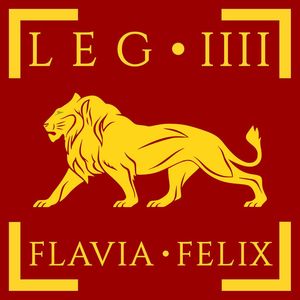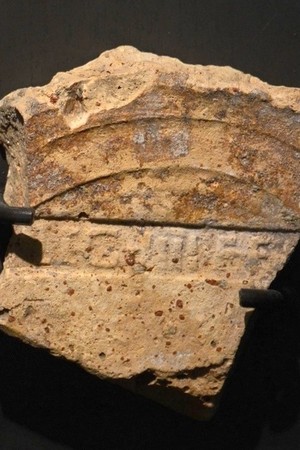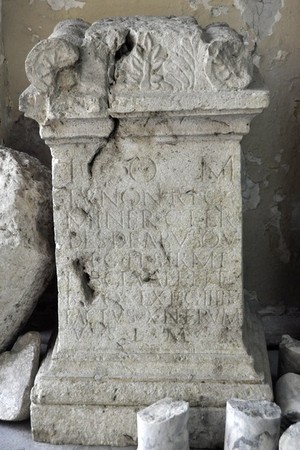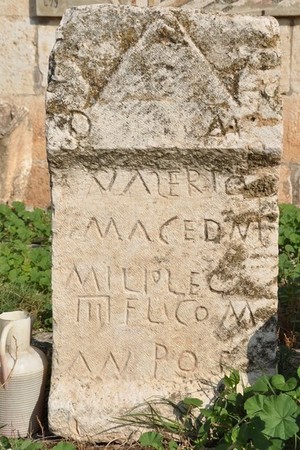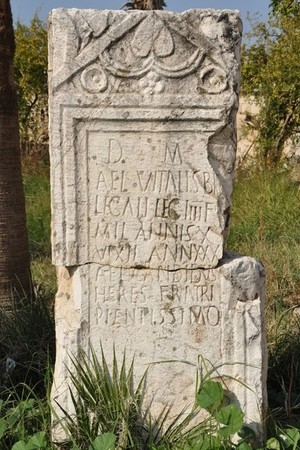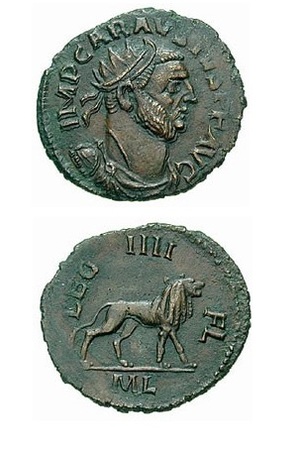Roman Legion - Legio IIII Flavia Felix
Legio IIII Flavia Felix (Fourth Flavian Fortunate Legion) was a Roman legion of the imperial era, formed from new recruits and legionaries of the disbanded Legio IV Macedonica due to its defeat in the Batavian revolt.
Dates of existence: 70 AD to the beginning of the 5th century AD
Symbol: Lion
Nickname: Antoniniana ("Antoninus's"); Severiana ("Severus's"); Gordiana ("Gordian's"); Pia Fidelis ("Loyal and Faithful")
Battle Path
- The legion was created in the summer of 70 AD from new recruits and legionaries of the disbanded Legio IV Macedonica, following its defeat in the Batavian revolt (70 AD).
- Vexillations of the legion participated in many military campaigns across various provinces of the empire, but the main forces of the legion were almost always stationed on the Danube border and participated in military campaigns along this frontier.
- The first camp of the new legion was located in Dalmatia. Dalmatia is a historical region in the northwest of the Balkan Peninsula, along the Adriatic Sea, encompassing modern Croatia (most of it) and Montenegro (a smaller part). The legion was stationed in the city of Burnum, replacing Legio XI Claudia, which was transferred to the Rhine.
- In the early years of the new legion, its legate was the future renowned Roman jurist Lucius Javolenus Priscus.
- Historians still debate the origin of the cognomen "Felix" ("fortunate"). Some believe the legion received it for a military success, while others think it was given from its inception.
- During Emperor Domitian's reign (81-96 AD), veterans from the legion were settled in the city of Scupi (now Skopje in North Macedonia).
- In 88 AD, the legion again took part in a new campaign against the Dacians and participated in the Battle of Tapae, where Rome emerged victorious, avenging the defeat of Prefect Cornelius Fuscus by the Dacians in 86 AD.
- In 88 AD, the legion again took part in a new campaign against the Dacians and participated in the Battle of Tapae, where Rome emerged victorious, avenging the defeat of Prefect Cornelius Fuscus by the Dacians in 86 AD.
- Under Emperor Trajan, Legio IIII Flavia Felix first built roads north of the Danube (98 AD) and then participated in Trajan’s first Dacian campaign (101-102 AD). For a short period, the legion was camped in the former Dacian capital, Sarmizegetusa (now ruins in southwest Transylvania, in the Orăștie Mountains, Romania).
- Between the first and second Dacian campaigns of Emperor Trajan, the legion built a fort near the city of Arad (now a city in Romania) to control the Sarmatian tribes and protect the road along the Mureș River (a modern river in Hungary and Romania, a left tributary of the Tisza River) connecting Dacia and Pannonia (a Roman province in Central Europe, covering modern Hungary, eastern Austria, southwest Slovakia, northern Slovenia, northern Croatia, northeastern Serbia, northern Bosnia and Herzegovina).
- The legion then participated in Trajan's second campaign against the Dacians (105-106 AD), which ended with the complete victory over the Dacians and the transformation of Dacia into a Roman province.
- After the Dacian wars, the legion was stationed in Berzobis and guarded the Iron Gates (a narrowing in the Danube Valley at the convergence of the Carpathian and Stara Planina mountains, a river gate on the border of Serbia and Romania).
- From 108-117 AD, it was engaged in building fortifications and public buildings in Sarmizegetusa.
- Additionally, vexillations of the legion were stationed in the forts of Ampelum and Bocsa, guarding the gold mines. Tiles stamped with Legio IIII Flavia Felix have been found there.
- Another vexillation of the legion was stationed in the fortress of Micia, where an inscription made between 101-117 AD by a centurion of the legion, Quintus Licinius Macrinus, in honor of his legion, has been preserved.
- During the reign of Emperor Hadrian, the legion was transferred back to Singidunum in 119 AD, where it patrolled roads along the Mureș River.
- For a short period, a vexillation of the legion was stationed in the city of Apulum (now Alba Iulia, in Transylvania, Romania), known for its gold mines.
- In the 2nd century, vexillations of Legio IIII Flavia Felix often substituted for Legio II Adiutrix when it went on various military campaigns from its base in Aquincum (now ancient ruins within the city of Budapest, Hungary).
- Additionally, several vexillations of the legion guarded roads in the province of Upper Moesia.
- During Emperor Antoninus Pius's reign (138-161 AD), a vexillation of the legion possibly participated in a campaign against the Moors.
- From 161-166 AD, Legio IIII Flavia Felix likely participated in the war with Parthia and the campaign against it during Emperor Lucius Verus's reign.
- Later, under Emperor Marcus Aurelius, Legio IIII Flavia Felix participated in the Marcomannic War (166-180 AD).
- In Year of the Five Emperors (193 AD), the legion supported Septimius Severus.
- Around 200 AD, veterans of the legion, along with veterans of Legio VII Claudia, were settled in the city of Naissus (now Niš, in Serbia).
- When Legio II Adiutrix participated in the Parthian war, vexillations of Legio IIII Flavia Felix occupied Aquincum.
- Most likely, in the 3rd century, the legion or its vexillations participated in campaigns against the Parthians and Persians.
- In the 3rd century, during the reigns of Emperors Caracalla, Alexander Severus, Maximinus I Thrax, and Gordian III, the legion received honorary epithets (“Antoninian”; “Alexander’s”; “Maximin’s”; “Gordian’s”).
- In 235 AD, the legion fought in Germany, as evidenced by finds in Harzhorn (a mountain range in northern Germany).
- The legion also participated in a campaign against the Alemanni, either under Emperor Caracalla (213 AD), Emperor Alexander Severus (235 AD), or Emperor Maximinus Thrax in 235-236 AD.
- During Emperor Philip I the Arab's reign, veterans of the legion were settled in the Samaritan city of Flavia Neapolis (now Shechem, Nablus, on the west bank of the Jordan River, Palestinian Authority).
- In 249 AD, during the power struggle between the reigning Emperor Philip I the Arab (244-249 AD) and the contender, who ultimately triumphed, Decius Trajan, the legion supported Decius Trajan.
- Under Emperor Gallienus (253-268 AD), a coin was issued in honor of the legion (around 260 AD), after which it received the honorary epithet “Gallien’s”.
- A vexillation of the legion was present in Gaul during the rule of the third emperor of the so-called Gallic Empire (a temporary entity that emerged during the crisis of the III century in the Roman Empire on the territory of Roman Gaul), Victorinus, as his coins mention Legio IIII Flavia Felix.
- In the Late Antiquity period(4th-5th centuries), the legion still existed, and its vexillations participated in Emperor Maximian's military campaign against the Bagaudae (supporters of independence from Rome in northwestern Gaul and northeastern Spain in the 3rd-5th centuries) in 285-290 AD, as well as against the usurper Carausius (a Roman usurper who rebelled against Emperor Maximian and ruled from 287 to 293 in Britain and northern Gaul).
- In 297-298 AD, a vexillation of the legion participated in the suppression of the rebellion of Domitius Domitian (a Roman usurper who ruled Egypt in 297). After this, it was transferred to Arabia Petraea (Arabia, a frontier province of the Roman Empire created in the early 2nd century) to build a road connecting several important forts in the province.
- Presumably, the Gallic vexillation of the legion sided with Constantine I the Great.
- According to the Notitia Dignitatum around 400 AD, Legio IIII Flavia Felix was still camped in Singidunum and commanded by a prefect under the dux of Moesia Prima.
Related topics
List of Roman Legions, Legion, Legionnaire, Marcus Ulpius Nerva Trajan, Year of the Five Emperors, The crisis of the 3rd century in the Roman Empire, Notification Dignitatum
Literature
1. Dando-Collins. “Legions of Rome.”
2. Y. Le Bohec and K. Wolff, "Legiones Moesiae Superioris," in Jan Le Bohec, "Les Légions de Rome sous l’Empire" (2000 Lyon) 239-245.
3. I. Piso, "Legends of the Province of Dacia," in: Jan Le Bohec, "Les Légions de Rome sous l’Empire" (2000 Lyon) 205-225.
4. R. Cania. "A Brief History of Various Legions."

 Gallery
Gallery






